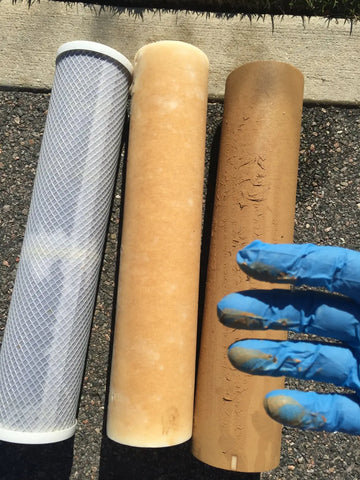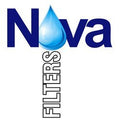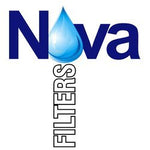Whole House Water Filters
Whole House Water Filter
Whole house water filter systems do just what their name implies — they filter water that enters your home before it makes its way into different rooms. So, if you install a whole house system to reduce sediment, chlorine, chloramines, and other contaminants in your water, you'll enjoy cleaner, refreshing water in no time. It will not just clean water from the faucet, either. A whole house water filter cartridge will also clean the water in your shower, laundry, and dishwasher as well.
So, what’s the best whole house water filter for cleaning your water?
We will answer this question a little later on. First, let’s look at how a whole house filter cleans your water:
Why do you need a whole house water filter?
Whole house water filters remove harmful elements from your drinking water. Though many substances can enter the water supply, there are three categories that you should be the most concerned about: sediment, chemicals, and plastics. Over time, these three elements can wreak havoc on your drinking water, eventually causing damage to your appliances faucets etc and your health.
First, let’s take a look at sediments:
Sediment Removal
| Sediments are tiny particles of rust, clay, sand, and other similar materials. They commonly work their way into water supplies after storms, though they can also get in with virtually no outside help. Since these sediments are so small, it’s very easy for them to enter the water before it reaches your home. Generally, if you see buildup on your faucets or other surfaces it is mistakenly thought to be scale or calcium, there maybe calcium but a higher percentage is sediment- when these are filtered out these deposits diminish dramatically in some homes completely. Our filters stop the sediment. |
 |
| This set clearly shows trapped sediment after 26,000 (the filter on the left is carbon The carbon is on the left in the picture above , observe how clean it is because the other two cartridges have removed the sediment beforehand. Dramatically improving its service life. |
Now lets look at the Coconut Carbon in Nova Filters
Carbons are made from different raw materials possessing vastly different pore size ranges and iodine ratings, which lend themselves toward certain applications. Carbon can be made in many different ways and each type is best suited to a different application. Over the years Nova tested and developed the highest-grade coconut carbon used initially in our aquarium stores over 20 years ago. The results with delicate marine & tropical fish were obvious they were thriving in this purified water.
Carbon is very effective at removing many contaminants, including the following:
- Residual chlorine and monochloramine
- Taste and odor causing organic contaminants
- Volatile organic compounds (VOCs)
- Trihalomethanes (TTHMs) and other halocarbons
- Endocrine disrupting compounds (pharmaceuticals, personal care products, etc.)
- Chloramine, hydrogen sulfide and hydrogen peroxide (removed by catalytic carbons)
Carbon must not be the sediment filter, it is best for it to act only as an adsorbent for dissolved organics, not the filtration of solids. When a system doesn't pre-filter sediments the carbon gets coated with the sediment in so doing there is no longer direct contact of the carbon and water without contact it will not work effectually.
Therefore, small single carbon filters or canisters just don't work efficiently they get clogged up with sediment then the carbon gets coated with sediment.
We use two sediment filters in the Nova Whole House filter before our carbon filter, the water passes thru three filters.
Carbon has a finite use based on gallons of water passing thru it. All carbons can only absorb so many contaminants before losing it’s effectiveness and its adsorption efficiency. This happens when the pore structure of the carbon is so full that it cannot adsorb any more impurities. At 26,000 gallons, the Nova Carbon is typically deemed spent, and would need to be replaced.
We recommend carbon remain in drinking water filtration system for NOT more than 12 months. Interesting to note that carbon left unchanged in aquariums will have a detrimental effect on live aquaria due to loss of its effectiveness.
There is more than one company selling carbon tank filters claiming they will last 5 years I cringe when I see this here’s why.
Carbon filters in water filters have a limited ability to adsorb contaminants from water, and so the carbon filter in water purifiers should be changed when it has been depleted and cannot purify water anymore.
At this stage the carbon will start rejecting some of the previously adsorbed pollutants back into the water flowing over it. This is called ‘breakthrough’. When this happens, the concentration of pollutants in the treated water will be higher than in the raw water being treated.
We use the best activated coconut hay carbon in our Nova water purification system this proprietary aquarium grade carbon has the highest iodine rating available is the microporous type and they are best for removal of chlorine and its by-products called TTHM's and volatile organic compounds or VOCs in water. We have test results from an independent laboratory taken from homes in The Villages Fl. that clearly demonstrate this.
Nova high grade carbon in not available anywhere online or in retail stores except from us, there are lesser quality charcoal carbons on the market perhaps at a lower cost but why not have the best for the heath and well being of you and your family.
Chemicals Taste & Odor
Most harmful chemicals are removed from the water when it is treated in the public water treatment system. However, chlorine is one common chemical that remains. In fact, chlorine is added to the water supply to act as a disinfectant. However, once it has killed any viruses and bacteria, it doesn’t need to stay in your drinking water. Chlorine gives water a bleach-like taste and aroma. Additionally, long-term consumption of chlorine can have negative effects on your health.
MicroPlastics
| Microplastics has been found in tap water across the world, including the United States. In fact, the US has some of the highest rates of microplastics in drinking water of any country in the world. These plastics can do untold damage to your health and the health of your family. Consumption of microplastics can even lead to a number of devastating diseases, including cancer. Current standard water treatment systems do not filter out all of the microplastics, In terms of fibres, the diameter of the fibers is greater than 10 microns across and The Nova Filter surpasses that desired level of filtration suggested by these scientists |

Microplastics has been found in tap water across the world, including the United States. In fact, the US has some of the highest rates of microplastics in drinking water of any country in the world. These plastics can do untold damage to your health and the health of your family. Consumption of microplastics can even lead to a number of devastating diseases, including cancer.
Nova - The Best Whole House Water Filter
Unlike other whole house water filters, the Nova home drinking water filtration system is one-size-fits-all.
It is capable of filtering up to 26,000 gallons before replacement. You can monitor the durability of your filter via your utility bill or the addition of a meter on your filter. Either way, each filter will provide high-quality filtration for a period of 7-12 months. On Average a person household uses 2-4,000 gallons of water a month. The Nova whole house filter replacements are sold in sets of three for just $85.
The whole house system is low-maintenance, eco-friendly, and contains three distinct filters to treat your home’s water. The coconut carbon filter addresses chlorine, taste, oder, pharmaceuticals, pesticides, and other chemicals, while the two extra-large sediment filters reduce sand, sediment, silt, microplastics, and suspended debris. A Nova brand filter can even function as a well water filtration system.
Many other brands use small, 10” sediment filters. Not only is that size ineffective, but a lot of the sediment that bypasses the sediment filter ends up clogging the carbon filter. Carbon needs direct contact with water, so if the carbon has a coating or buildup of sediment, it’s effectiveness is greatly diminished.
Nova Filtered Water vs. Bottled Water
Finally, if you choose a Nova water filter, you will have the highest quality, purified water with a terrific taste and smell. First, your tap water is treated by your local water utility and then receives our additional filtration. This means that Nova’s whole house filtration adds a second layer of defense between you and any harmful elements, making it the best home water filtration system on the market.
Interestingly, many people may think that bottled water is held to the same standards as tap water, but this is not the case. Studies have shown that about 1/3 of tested bottled water violated enforced state standards or exceeded microbiological purity guidelines. With whole house water filtration, you can avoid the harmful chemicals left behind in bottled water. Additionally, whole house filtration is ultimately cheaper and better for the environment than bottled water.
Conclusion
If you want to have the cleanest drinking water possible, there is no better choice than the Nova whole house water filter cartridge. Nova currently provides the best whole house water filter on the market, beating the competition at both quality and price. Additionally, Nova’s whole house water filtration provides superior quality to both tap and bottled water.

